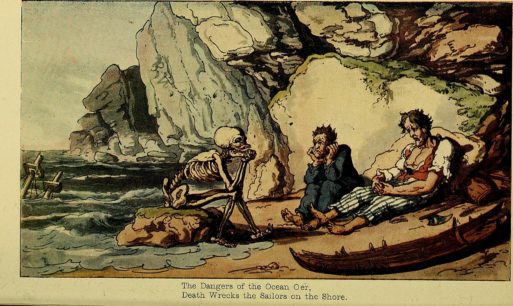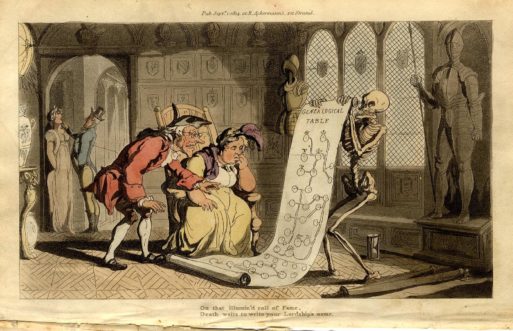
Credit: art.com
Artistic traditions have dealt with death as a subject for as long as people have been making art. Like most other traditions associated with death, these have often been born out of beliefs both religious and practical. The history of the world is the history of art, and art often tells us a lot about the time in which it was created. This is certainly the case with art about death, so it’s no surprise that the Middle Ages produced a particularly ominous, and sometimes humorous, genre known as the “Danse Macabre,” or Dance of Death. First appearing around 1425, these works usually feature images of Death leading people to the afterlife, and they are often dancing.
The 15th century was a tough time to be alive. With recurring famines, the Hundred Years War and the Black Death, most lived with the knowledge that a horrible death could be right around the corner for anyone, regardless of their station in life. Dance of Death art from this period certainly reflects this reality, and often features people from many different social classes dancing together with Death. These works are purpose-driven. They served to remind people that they should repent and prepare to meet their maker, but also as a statement that we should try to take joy in life regardless how short and brutal it may be. Like many historic artistic traditions, these works often feature symbols widely associated with death at the time, and were easily understood as warnings by laypeople.
Thomas Rowlandson and William Combe’s Dance with Death
The tradition continued in much the same vein until the 1815 publication of “The English Dance of Death” (vols 1 and 2) by Thomas Rowlandson and William Combe. Rowlandson was a popular English caricature artist and satirist of the time. Combe was a somewhat obscure writer who did much of his work from a debtor’s prison. The two collaborated on two well-known works, with Combe writing in meter to accompany Rowlandson’s prints.

Credit: commons.wikipedia.org
Rowlandson’s takes on the Dance of Death often satirize English society of the period, using contemporary scenes and characters from the 19th century. They are often irreverent towards institutions and practices of the day, but they do uphold the theme of warnings against bad actions. Figures are often grotesque, and don’t inspire much sympathy for the damned.
Rowlandson’s beautifully-colored prints make the ideal fodder for Combe’s wit, and there are some real gems in this work. For example, one piece warning against excessive drink shows Death carting away a dead man as his wife protests and his friends laugh gleefully at the pub – the verse below the print reads;
Drunk and alive, the man was thine,
But dead & drunk, why, -he is mine.
Another piece, aimed at the nobility, depicts Death showing a genealogical chart to a nobleman with the quote:
On that illumin’d roll of Fame,
Death waits to write your Lordship’s name.

Credit: fulltable.com
The book consists of a total of 72 prints, and works well as a coffee table read. Check it out for one of the most lighthearted takes on the Dance of Death tradition rendered in a satirical style that makes it very much a statement on life in Georgian England, and still quite enjoyable today.

 The English Dance of Death
The English Dance of Death


 “In Case You Don’t Live Forever” by Ben Platt
“In Case You Don’t Live Forever” by Ben Platt
 Our Monthly Tip: Make an “In Case of Death” File to Ease Loved One’s Grief
Our Monthly Tip: Make an “In Case of Death” File to Ease Loved One’s Grief
 Passing of Beloved Comedian Births a New Comedy Festival
Passing of Beloved Comedian Births a New Comedy Festival














